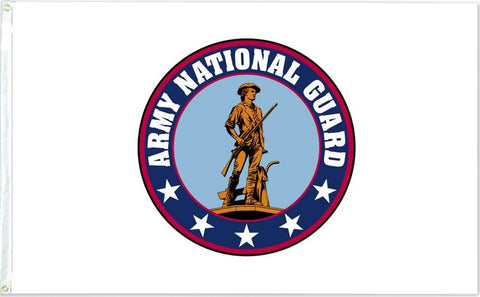
Drive through any town in the United States and in addition to the U.S. flag you might see a service specific flag mounted on a front porch alongside of Old Glory. Veterans like to show their service pride. It isn’t uncommon to find an Army, Navy, Air Force, Marines, Coast Guard or Space Force flag flying on the home of a veteran.
When I was in the Army National Guard, some of my fellow Guard personnel flew an Army National Guard flag on their drill weekends as a way to let their neighbors know that they were on duty for their community and country. They also posted the Army National Guard flag when they went away for training or when they were on their annual training orders, and when they got mobilized to serve overseas in America’s war on terror.
Flags have their roots in military history. They were initially used to signal forces on the battlefield. China is credited for having the first flags that represented a ruler. Today, there is an international maritime flag signal code still in use, but the bottom line is, if you fly a particular flag, it conveys a message about who you are and what you believe.
The Army National Guard flag is easily identifiable. It has a Revolutionary War minuteman holding a musket on it, but in case someone doesn’t recognize the flag, “Army National Guard” is emblazoned on the seal. But while the Army National Guard flag might be easily recognized, the purpose and mission of the National Guard remains a mystery for some Americans, much like military service.
Americans know that there are military people who respond and help during natural disasters and civil unrest. Some of those people might know that the uniformed personnel are from the National Guard, but ask them to offer some details about the National Guard and most will answer with a shrug.
According to National Guard historians, the National Guard traces its lineage to English colonial militias that were formed to combat Native Americans in 1636. Some states, like Florida, claim that their military heritage dates back farther than 1636. The Florida National Guard, for example, traces its heritage to 1565 when Spanish colonial militias first mustered. These militias required all able-bodied men to keep a musket and to muster as needed to defend the colony. The militias were usually under local control and led by a leader elected to the position.
In the 1700s, the militias continued defending their colonies as colonial expansion provoked Native Americans to fight, but the militias fought other nations as well to control interests in America. Eventually, the English colonial militias became American militias when they took up arms against the British Empire in the Revolutionary War. Since its inception, the National Guard has fought in most American Wars and it has responded to many domestic emergencies.
During peacetime each state, the district of Columbia and three U.S. territories, have a National Guard that is led by an adjutant general who reports to the governor. During national emergencies, however, the U.S. president can mobilize the National Guard, putting them in federal duty status. Governors can mobilize their National Guards domestically for emergencies.
According to the National Guard, “Even when not federalized, the Army National Guard has a federal obligation (or mission). That mission is to maintain properly trained and equipped units, available for prompt mobilization for war, national emergency, or as otherwise needed.”
The Army National Guard’s state mission is perhaps the most visible. National Guard units respond to wildfires, floods, tornadoes, hurricanes, snowstorms, pandemics or other emergency situations, including civil unrest.
Yet, despite its high visibility missions, the Army National Guard has struggled with brand recognition. The Army National Guard's logo, which has been used since the 1950s, does not resonate with Americans of military service age. The Minuteman logo, as it is often referred to, is not reflective of a modern Army. The Minuteman logo is on the Army National Guard flag.
A few years ago, the Army Marketing and Research Group (AMRG) studied the Army National Guard’s logo and concluded that “The Minuteman, an image revered by many in the ARNG [Army National Guard], was not well understood or recognized in testing,” according to the 2019 Army National Guard Branding Guidelines. “Department of Defense research has not found that a service’s history is a strong motivator for youth to consider military service; as such, ARNG does not plan to use the Minuteman in its recruiting efforts.”
The National Defense Authorization Act of Fiscal Year 2017 directed the Army National Guard to merge its marketing activities with the AMRG. The directive ordered the Army, Army Reserve and Army National Guard to consolidate into a single organization, all marketing functions to ensure unity of effort and cost effectiveness. This congressionally mandated change came from 2015 recommendations of the National Commission on the Future of the Army.
In December 2018, the Army National Guard introduced its new brand and branding guidelines for all U.S. states, territories and the District of Columbia. The most noticeable change was removal of the minuteman from the Army National Guard flag and the use of a new logo. The minuteman is no longer used for external marketing.
The new logo includes a gold star on a black background and the words “Army National Guard” emblazoned on a shield-like shape, using gold and white lettering. The name of the state, territory or district is included on the new logo. The new Army National Guard logo closely resembles the Army’s logo.

Army officials have said that the goal of the rebrand was to show that the Army National Guard was an important part of the Total Force and that the Army National Guard works in harmony with its Army Reserve and active Army counterparts.
Another goal of the Army National Guard’s rebrand was to make the service more appealing and reflective of a modernized military to help align local and national marketing efforts. The hope is that the strategy will better communicate the Army National Guard’s mission and make the brand more recognizable at a local level by tying it to the larger Army.
“The logo-specific research involved several potential logo options, color schemes, shapes, and elements reflecting ARNG [Army National Guard] legacy imagery such as the Minuteman and a stylized flag,” the 2019 Army National Guard Branding Guidelines states. “For every option tested, a State-specific version was also tested. The approved logo performed best among prospects and influencers. Data analysis did not find significant regional differences in logo preferences. The Minuteman, an image revered by many in the ARNG, was not well understood or recognized in testing.”
I asked the National Guard Bureau (NGB) and the Army’s Center of Military History earlier this year if they believed that aligning the Army National Guard’s lineage to the English colonial militias was socially responsible given the English militia’s violent past against Native Americans, and given the social justice current in American society. They never responded directly to the question.
“The Center of Military History currently has no effort underway to evaluate the lineage and honors of units and determine whether the members of any particular unit might have been involved in a human rights violation,” U.S. Army Center of Military History Chief Historian Jon Hoffman said.
While NGB and the U.S. Army Center of Military History will not revisit the Army National Guard’s historical alignment, the AMRG’s study on the Minuteman logo captured how some in American society feel about what the era of the minuteman represents.
“In each focus group location, the Minuteman drew some negative reactions from participants due to an association with eras in American history that were not empowering for women and people of color,” The Army’s Branding Guidelines say. “Due to the significance of the Minuteman in the proud history of the Guard, and the youth market’s general disinterest in history as a motivator to consider ARNG [Army National Guard] service, HRR does not recommended use of the Minuteman in recruiting.”
The Army National Guard has said the Minuteman logo will continue to be used internally. On the National Guard’s website the Minuteman logo is still displayed and used prevalently as a symbol to represent the broader National Guard, which includes the Air and Army National Guards. There is no firm deadline as to when the Army National Guard will stop using the Minuteman logo.
The minuteman Army National Guard flag, like flags of old, signals a message. It communicates, but what it conveys depends on who is looking at it.
1 comment
I joined the Nebraska army national guard in 1981-1985, I was a young punk thought I new it all, what a wake up call, I learned about team work ,leadership, honor, and patriotism, from bootcamp to AIT, and my four year’s, made a man out of me, made so many friends, iam 60 now, I would go back and do it again, in these troubling times, we might need to change the logo, I love the original minute man logo, but young people need a path, and joining the Guard of your state has so many possibilities of a great career, I thank the National Guard for letting me serve and defend my state an country , GOD BLESS AMERICA, JAMES CHINOWTH “NANG”
Leave a comment
Please note: comments must be approved before they are published.